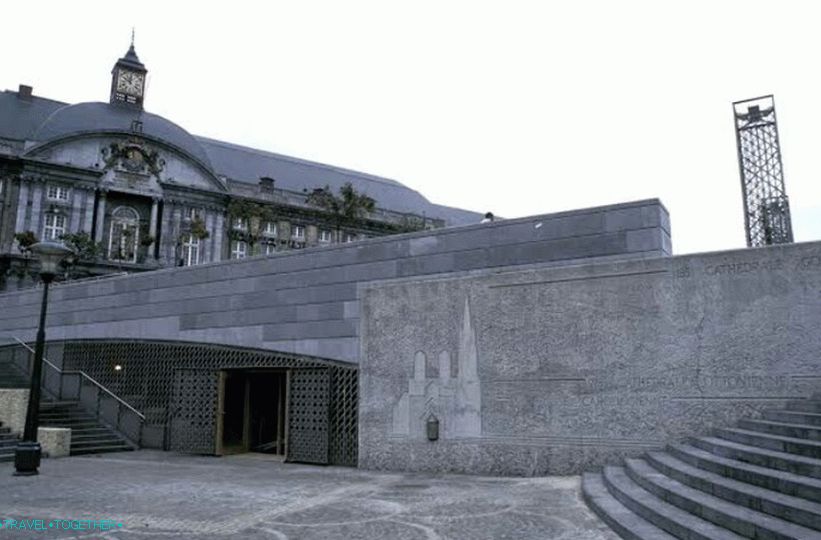Liege (Belgium) – the most detailed information about the city with photos. The main attractions of Liège with a description, guides and cards.
Contents
City Liege (Belgium)
Liege – a city in the east of Belgium, located on the river Maas. It has a rich industrial past, due to which inferior to the beauty of Bruges and Ghent. Liege – one of the most important historic cities of Belgium. This is one of the first places in Europe where began to mine coal. Now Liege is the main cultural center. Wallonia, including many museums and an eclectic mix architecture from the middle ages to modern times.
- Geography and climate
- Practical information
- Story
- How to get there
- sights
- Video
- Maps and guides
- Comments and reviews
Geography and climate
Liege is located in the eastern part of Belgium on the river Meuse. City has a temperate climate with cool summers and mild winters.
 Streets of Liege
Streets of Liege
Practical information
- The population is 195 thousand people.
- Area – 69.39 km².
- Currency – Euro.
- The language is French.
- Visa – Schengen.
- The best options for shopping in Liege are place Cathédrale and place Saint Lambert.
- Outside the city: Belle-Ile Shopping Center (can be reached by bus 377 from the opera) and Médiacité, including more than 100 stores.
- Traditional food: La tarte au riz (rice cake), Boulets sauce-lapin (meatballs with sauce and french fries), La potée liégeoise (rustic dish of beans, potatoes and bacon), Gaufre de Liège (famous waffles with caramelized sugar).
- Food in the cafes and restaurants of Liege is quite expensive.
Story
The environs of Liege were inhabited in ancient times. Settlement it was first mentioned in 558. In the 8th century, Liege became a city and one of the centers of Lorraine. Also this place is a cradle dynasty of the Carolingians.
In the 10th century, Liege became an independent principality, ruled by prince-bishop. Then, until the end of the 18th century, this principality was part of composition of the Holy Roman Empire. Interesting that the city never belonged to the Burgundian, Spanish or Austrian Netherlands.
 Liege
Liege
In 1789, a few weeks after the start of the French revolution, Liege experienced its own revolution during the absence Prince-Bishop. In 1792, the principality was abolished and annexed to France, which included until 1815. Then Liege became part of the United Kingdom of the Netherlands, and then the Kingdom of Belgium in 1830.
How to get there
Liege Airport specializes in cargo transportation. None however, it serves the following destinations: Alicante, Bodrum, Izmir, Catania, Heraklion, Malaga and some others, mainly southern cities. Although most likely to arrive at the airport Brussels, which has a lot more directions. From Brussels to Liege can be reached by train through Leuven.
High-speed trains connect Liege with Paris, Brussels, Cologne, Frankfurt. Easy to get here by bus from many cities. France, Germany and the Netherlands.
sights
 Palace princes bishops
Palace princes bishops
The Palace of the Bishops’ Princes is a historic building in which now are the court and the seat of the Walloon government. Palace dates back to the 15th century. He replaced the more ancient medieval a structure that was destroyed. The building is interesting because marks the transition from gothic to renaissance style. Notable The palace features are two picturesque courtyards with arched passages and columns. Interior unavailable for visitors.
The best place for a walk along Liege is the embankment of the river Meuse. Also There are several interesting sites here: Pont des Bridge Arches, built between 1858 and 1862 to replace the old 11th century bridge, meat hall, built in 1546, historical 16th century hotel. On the embankment of La Butte (La Batte Quay) in the first a half day market is held.
 Church St. Barthelemy
Church St. Barthelemy
St. Barthelemy Church – one of the main sacred monuments Liege. This beautiful church was built in the 11th – 12th centuries. At 18 century this religious building was greatly expanded, receiving two towers in the style of Romanesque architecture of the Rhine Valley. The most The church’s precious treasure is a bronze font cast between 1107 and 1118 years. Also of interest are the medieval choir and paintings by local artists.
One of the most beautiful streets of Liege is Féronstrée, which starts in the eastern part of the market square and goes through heart of the old town to the church of Saint Barthélemy. Most buildings who avoided demolition, belong to the 18th century. Here is a museum Walloon Art (Musée de l’Art Wallon), in which Presents paintings, sculptures and drawings of famous Walloon artists
 Basilica Saint-Martin
Basilica Saint-Martin
The Basilica of Saint-Martin is a late Gothic stone church. This religious building was founded in the 10th century and destroyed fire in 1312 during disputes between guilds and nobility. The church was restored in the 16th century and has beautiful stained glass windows, dating from 1526–1536 years.
The Maestricht Quay (Quai de Maestricht) is home to many interesting museums. Museum of Weapons (Musée d’Armes) stores magnificent collection of small arms, reflecting the traditions weapons production in Liege, dating back to the 14th century. Museum of Curtius (Musée Curtius) includes exhibits of prehistoric, roman and French medieval periods, as well as collections of furniture and decorative art from the Middle Ages to the French Revolution. This museum is located in a magnificent red brick building built in the renaissance style between 1600 and 1610 years.
 Church of sv. Paul’s
Church of sv. Paul’s
Church of sv. Paul – the cathedral of Liege. It’s gorgeous An example of Gothic architecture, founded in the 10th century. In structure The cathedral stands out for its beautiful tower, as well as the pulpit, arches and ceiling. The church has a beautiful interior, decorated between the 16th and 19th centuries. Several religious treasures were brought here from the ancient The Cathedral of Saint Lambert, which was destroyed.
The Museum of Walloon Life is one of the most interesting museums in Liege. It is located in the former Minorite monastery. His expositions include 350,000 exhibits and documents illustrating life and culture in Walloon region.
 Church of the Holy Jacob
Church of the Holy Jacob
The Church of St. James was founded in the 11th century and transformed into a magnificent example of late gothic architecture from 1513 to 1538 years The 12th century Romanesque portico on the west side was preserved, while the gorgeous north portal was reconstructed in the Renaissance style in the 16th century.
 Montagne de buren
Montagne de buren
Montagne de Buren – the top of a hill with a stunning panorama of Liege, which you can climb the winding stairs.
 Archeoforum
Archeoforum
Archeoforum – an archaeological site of almost 4,000 square meters, located on the square of St. Lambert. Includes the ruins of the eponymous medieval cathedral, destroyed in late 18th century, and an ancient Roman villa.
 Railway railway station
Railway railway station
The train station is an important transportation hub and magnificent an example of modern architecture.
Video
Maps and guides
Tourist Map of Liege






